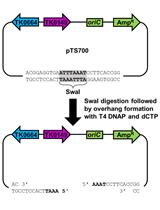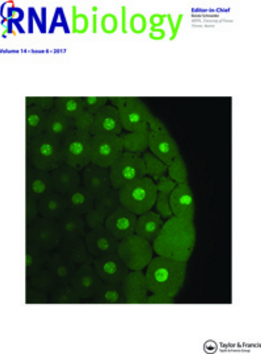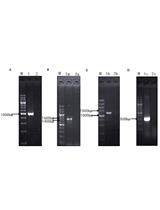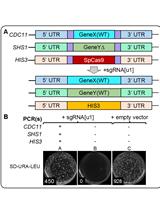- EN - English
- CN - 中文
Selection of Genetically Modified Bacteriophages Using the CRISPR-Cas System
利用CRISPR-Cas系统筛选基因组编辑的噬菌体
发布: 2017年08月05日第7卷第15期 DOI: 10.21769/BioProtoc.2431 浏览次数: 11409
评审: Modesto Redrejo-RodriguezAnonymous reviewer(s)

相关实验方案

超嗜热古细菌Thermococcus kodakarensis的无标记基因编辑
Alexandra M. Gehring [...] Thomas J. Santangelo
2017年11月20日 8313 阅读
Abstract
We present a CRISPR-Cas based technique for deleting genes from the T7 bacteriophage genome. A DNA fragment encoding homologous arms to the target gene to be deleted is first cloned into a plasmid. The T7 phage is then propagated in Escherichia coli harboring this plasmid. During this propagation, some phage genomes undergo homologous recombination with the plasmid, thus deleting the targeted gene. To select for these genomes, the CRISPR-Cas system is used to cleave non-edited genomes, enabling isolation of the desired recombinant phages. This protocol allows seamless deletion of desired genes in a T7 phage, and can be expanded to other phages and other types of genetic manipulations as well.
Keywords: Bacteriophage (噬菌体)Background
Bacteriophages (phages) are the most prevalent and widely distributed biological entity in the biosphere, highlighting their ecological importance (Suttle, 2007). Many studies also propose using phages for medical purposes (Weber-Dabrowska et al., 2001; Merril et al., 2003; Harper and Enright, 2011; Edgar et al., 2012; Bikard et al., 2014; Citorik et al., 2014; Yosef et al., 2014 and 2015). Unfortunately, only a few published methods detail genetic engineering of phage genomes (Selick et al., 1988; Marinelli et al., 2008; Pires et al., 2016) and in addition, some of these methods are tedious, and some cannot achieve desired results such as seamless deletions. A simple and efficient technique for seamless genetic engineering of phages is thus desired. In this protocol, we present a technique described in 2014 (Kiro et al., 2014) for deleting genes of the E. coli phage, T7. We first designed genetic constructs that facilitate desired homologous recombination events. We then used the CRISPR-Cas type I-E system to select desired engineered phages. Several other studies have also reported the use of CRISPR-Cas systems to engineer phages and the reader is referred to them for selecting the most appropriate and fitting protocols for the specific requirements (Martel and Moineau, 2014; Box et al., 2015; Lemay et al., 2017).
Materials and Reagents
- Materials
- 1.7 ml microfuge tube (Corning, Axygen®, catalog number: MCT-175-C )
- 15 ml tube (Corning, catalog number: 430052 )
- PCR tubes (Corning, Axygen®, catalog number: PCR-0208-C )
- Pipette tips
- Bacterial strains
- Electro-competent BL21-AI (Invitrogen, Genotype: F− ompT hsdSB(rB−, mB−) gal dcm araB::T7RNAP-tetA, tetr)
- Electro-competent NEB5α (New England Biolabs)
- Phage
- WT T7 phage (laboratory collection. Available at ATCC, catalog number: BAA-1025-B2 )
- Plasmids
- pUC19 (Yanisch-Perron et al., 1985)
- pWUR397 (Brouns et al., 2008. cas3 under T7 promoter, KanR)
- pWUR400 (Brouns et al., 2008. cascade genes under T7 promoter, StrR)
- pWUR477 (Brouns et al., 2008. pACYCDuet-1 (Novagen) cloned with control spacers under T7 promoter, camR)
- Enzymes
- DpnI restriction enzyme (New England Biolabs, catalog number: R0176S )
- T4 polynucleotide kinase (New England Biolabs, catalog number: M0201S ) used with T4 DNA ligase buffer (New England Biolabs, catalog number: M0202S )
- Kits
- Gel and PCR Clean-up Kit (MACHEREY-NAGEL, catalog number: 740609.50 )
- KAPA HiFi PCR Kit (Roche Diagnostics, catalog number: 07958935001 )
- Lamda Taq PCR Master mix (Lamda Biotech, catalog number: D123P-200 )
- Quick Ligation Kit (New England Biolabs, catalog number: M2200L )
- Reagents
- Agar (BD, DifcoTM, catalog number: 214010 )
- Ampicillin (Merck, catalog number: 171254 ; Stock 100 mg/ml in double-distilled water, filtered, -20 °C)
- Chloramphenicol (Merck, catalog number: 220551 ; Stock 35 mg/ml in ethanol, filtered, -20 °C)
- Isopropyl-β-D-thiogalactopyranoside (IPTG) (Bio-Lab, catalog number: 16242352 ; Stock 1 M in double-distilled water, filtered, -20 °C)
- Kanamycin (Merck, catalog number: 420311 ; Stock 50 mg/ml in 50% glycerol and double-distilled water, filtered, -20 °C)
- L-arabinose (Gold Bio, catalog number: A-300-1 ; Stock 20% in double-distilled water, filtered, RT)
- LB (Luria-Bertani) medium (10 g/L tryptone, 5 g/L yeast extract and 5 g/L NaCl) (Acumedia)
- Molecular biology water (Bio-Lab, catalog number: 232123 )
- PEG 8000 (polyethylene glycol) (Promega, catalog number: V3011 ; Stock 50% in double-distilled water, filtered, RT)
- Streptomycin (EMD Millipore, catalog number: 5711 ; Stock 50 mg/ml in double-distilled water, filtered, -20 °C)
- TAE buffer (Bio-Lab, catalog number: 20502323 )
- LB medium (see Recipes)
- LB agar plates (see Recipes)
- Soft agar (see Recipes)
- TAE buffer (see Recipes)
Equipment
- Cell density meter (OD600 reader) (Amersham Biosciences, model: Ultrospec 10 )
- Electroporation device (Bio-Rad Laboratories, model: MicroPulserTM )
- Gel electrophoresis apparatus (Cleaver Scientific, model: MultiSUB Choice )
- Micro-centrifuge (Eppendorf, model: MiniSpin® )
- NanoDrop spectrophotometer (Thermo Fisher Scientific, Thermo ScientificTM, model: NanoDropTM 2000c )
- Pipettes
- Shaker (for 50 ml tubes, at 37 °C) (Thermo Fisher Scientific, Thermo ScientificTM, model: MaxQTM 2000 )
- Thermal Cycler (Bio-Rad Laboratories, model: C1000 TouchTM )
- Thermoblock (Labnet International, model: AccuBlockTM Digital Dry Baths )
Procedure
文章信息
版权信息
© 2017 The Authors; exclusive licensee Bio-protocol LLC.
如何引用
Manor, M. and Qimron, U. (2017). Selection of Genetically Modified Bacteriophages Using the CRISPR-Cas System. Bio-protocol 7(15): e2431. DOI: 10.21769/BioProtoc.2431.
分类
微生物学 > 微生物遗传学 > DNA > 染色体
分子生物学 > DNA > 诱/突变
您对这篇实验方法有问题吗?
在此处发布您的问题,我们将邀请本文作者来回答。同时,我们会将您的问题发布到Bio-protocol Exchange,以便寻求社区成员的帮助。
提问指南
+ 问题描述
写下详细的问题描述,包括所有有助于他人回答您问题的信息(例如实验过程、条件和相关图像等)。
Share
Bluesky
X
Copy link











